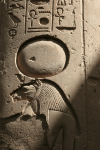A lot of the information on this page is from The Ancient Egypt Site (AES below), the site Ancient Egypt (AE below), and from Wikipedia. These sites have a lot of information and consistent time lines, although they differ. All the hieroglyphic names are from the AE website. The times are from Wikipedia.
From the Late Period of ancient Egypt entry in Wikipedia:
The Late Period of ancient Egypt refers to the last flowering of native Egyptian rulers after the Third Intermediate Period in the 26th Saite Dynasty founded by Psamtik I, but includes the time of Achaemenid Persian rule over Egypt after the conquest by Cambyses II in 525 BCE as well. The Late Period existed from 664 BCE until 332 BCE, following a period of foreign rule by the Nubian 25th dynasty and beginning with a short period of Neo-Assyrian suzerainty, with Psamtik I initially ruling as their vassal. The period ended with the conquests of the Persian Empire by Alexander the Great and establishment of the Ptolemaic dynasty by his general Ptolemy I Soter, one of the Hellenistic diadochi from Macedon in northern Greece. With the Macedonian Greek conquest in the latter half of the 4th century BCE, the age of Hellenistic Egypt began
The 26th Dynasty, also known as the Saite Dynasty after its seat of power the city of Sais, reigned from 672 to 525 BCE, and consisted of six pharaohs. It started with the unification of Egypt under Psamtik I c. 656 BCE, itself a direct consequence of the Sack of Thebes by the Assyrians in 663 BCE. Canal construction from the Nile to the Red Sea began.
One major contribution from the Late Period of ancient Egypt was the Brooklyn Papyrus. This was a medical papyrus with a collection of medical and magical remedies for victims of snakebites based on snake type or symptoms.
Artwork during this time was representative of animal cults and animal mummies. This image shows the god Pataikos wearing a scarab beetle on his head, supporting two human-headed birds on his shoulders, holding a snake in each hand, and standing atop crocodiles.
The First Achaemenid Period (525–404 BCE) began with the Battle of Pelusium, which saw Egypt conquered by the expansive Achaemenid Empire under Cambyses, and Egypt become a satrapy. The 27th Dynasty of Egypt consists of the Persian emperors - including Cambyses, Xerxes I, and Darius the Great - who ruled Egypt as Pharaohs and governed through their satraps, as well as the Egyptian Petubastis III (522–520 BCE) (and possibly the disputed Psammetichus IV), who rebelled in defiance of the Persian authorities. The unsuccessful revolt of Inaros II (460-454 BCE), aided by the Athenians as part of the Wars of the Delian League, aspired to the same object. The Persian satraps were Aryandes (525–522 BCE; 518–c.496 BCE) - whose rule was interrupted by the rebel Pharaoah Petubastis III, Pherendates (c.496–c.486 BCE), Achaemenes (c.486–459 BCE) - a brother of the emperor Xerxes I, and Arsames (c.454–c.406 BCE).
The 28th Dynasty consisted of a single king, Amyrtaeus, prince of Sais, who rebelled against the Persians. He left no monuments with his name. This dynasty reigned for six years, from 404 BCE – 398 BCE.
The 29th Dynasty ruled from Mendes, for the period from 398 to 380 BCE.
The 30th Dynasty took their art style from the 26th Dynasty. A series of three pharaohs ruled from 380 BCE until their final defeat in 343 BCE led to the re-occupation by the Persians. The final ruler of this dynasty, and the final native ruler of Egypt until nearly 2,300 years later, was Nectanebo II.
The Second Achaemenid Period saw the re-inclusion of Egypt as a satrapy of the Persian Empire under the rule of the 31st Dynasty, (343–332 BCE) which consisted of three Persian emperors who ruled as Pharaoh - Artaxerxes III (343–338 BCE), Artaxerxes IV (338–336 BCE), and Darius III (336–332 BCE) - interrupted by the revolt of the non-Achaemenid Khababash (338–335 BCE). Persian rule in Egypt ended with the defeat of the Achaemenid Empire by Alexander the Great, who accepted the surrender of the Persian satrap of Egypt Mazaces in 332 BCE, and marking the beginning of Hellenistic rule in Egypt, which stabilized after Alexander's death into the Ptolemaic Kingdom.
Following is the list of Egyptian Pharaohs as well as I could determine it:
All pictures are © Dr. Günther Eichhorn, unless otherwise noted.
| Name of Pharaoh | Dates | Birth Name | Coronation Name | Horus Name | Comment |
|---|---|---|---|---|---|
| (from The Ancient Egypt Site and Ancient Egypt) | |||||
Late Dynastic Period (AES Wiki ) | 672 - 332 BCE | ||||
26th Dynasty (AES Wiki AE) | 672 - 525 BCE | ||||
| Nekau I (Menkheperra) (Wiki) | 672 - 664 BCE | n/a | |||
| Psamtek I (Wahibra) (Wiki) | 664 - 610 BCE | ||||
| Nekau II (Wiki) | 610 - 595 BCE | ||||
| Psamtek II (Neferibra) (Wiki) | 595 - 589 BCE | ||||
| Apries (Haaibra) (AES Wiki) | 589 - 570 BCE | ||||
| Ahmose II (Khnemibra) (Wiki) | 570 - 526 BCE | ||||
| Psamtek III (Ankhkaenra) (Wiki) | 526 - 525 BCE | n/a | |||
27th Dynasty (Persians) (AES Wiki AE) | 525 - 404 BCE | ||||
| Cambyses II (Wiki) | 525 - 522 BCE | ||||
| Bardiya (Wiki) | 522 BCE | n/a | n/a | n/a | |
| Petubastis III (Wiki) | 522 - 520 BCE | n/a | |||
| Darius I (Wiki) | 522 - 486 BCE | ||||
| Xerxes I (Wiki) | 486 - 465 BCE | n/a | n/a | ||
| Artabanus (Wiki) | 465 - 464 BCE | n/a | n/a | n/a | |
| Artaxerxes I (Wiki) | 465 - 424 BCE | n/a | n/a | ||
| Xerxes II (Wiki) | 425 - 424 BCE | n/a | n/a | n/a | |
| Sogdianus (Wiki) | 424 - 423 BCE | n/a | n/a | n/a | |
| Darius II (Wiki) | 423 - 404 BCE | n/a | n/a | ||
| Artaxerxes II (Wiki) | 404 - 402 BCE | n/a | n/a | ||
28th Dynasty (AES Wiki AE) | 404 - 398 BCE | ||||
| Amyrtaios (Wiki) | 404 - 398 BCE | n/a | n/a | ||
29th Dynasty (Egyptians) (AES Wiki AE) | 398 - 380 BCE | ||||
| Nefaarud I (Wiki) | 398 - 393 BCE | n/a | |||
| Hernebkha Muthis (Wiki) | 393 - 393 BCE | n/a | n/a | n/a | |
| Psammuthes (Wiki) | 393 - 393 BCE | n/a | |||
| Hakor (Achoris) (Wiki) | 393 - 380 BCE | n/a | |||
| Nefaarud II (Wiki) | 380 BCE | n/a | n/a | ||
30th Dynasty (last Egyptian Pharaoh) (AES Wiki AE) | 380 - 343 BCE | ||||
| Nectanebo I (Kheperkara) (Wiki) | 380 - 362 BCE | n/a | |||
| Djedher/Takhos/Teos (Irma Atenre) (Wiki) | 362 - 360 BCE | n/a | n/a | ||
| Nectanebo II (Senedjemibra Setepenanhur) (Wiki) | 360 - 343 BCE | n/a | |||
31st Dynasty (Wiki AE) | 343 - 332 BCE | ||||
| Artaxerxes III (Wiki) | 343 - 338 BCE | n/a | n/a | n/a | |
| Artaxerxes IV (Arses) (Wiki) | 338 - 336 BCE | n/a | n/a | n/a | |
| Khababash (Wiki) | 338 - 335 BCE | n/a | |||
| Darius III Codomanus (Wiki) | 336 - 332 BCE | n/a | n/a | ||
|
|
|
Greek Period
|
Here are the links to the other pages on Egypt:






Page last updated on Tue Nov 2 17:23:32 2021 (Mountain Standard Time)
Page last updated on Fri Apr 26 14:10:26 2024 (Mountain Standard Time)
Egypt - Pharaohs of the Late Period - 672 - 332 BCE on guenther-eichhorn.com